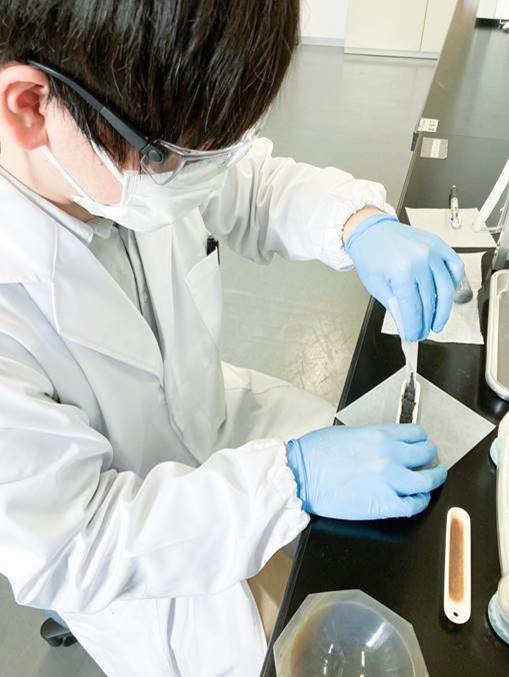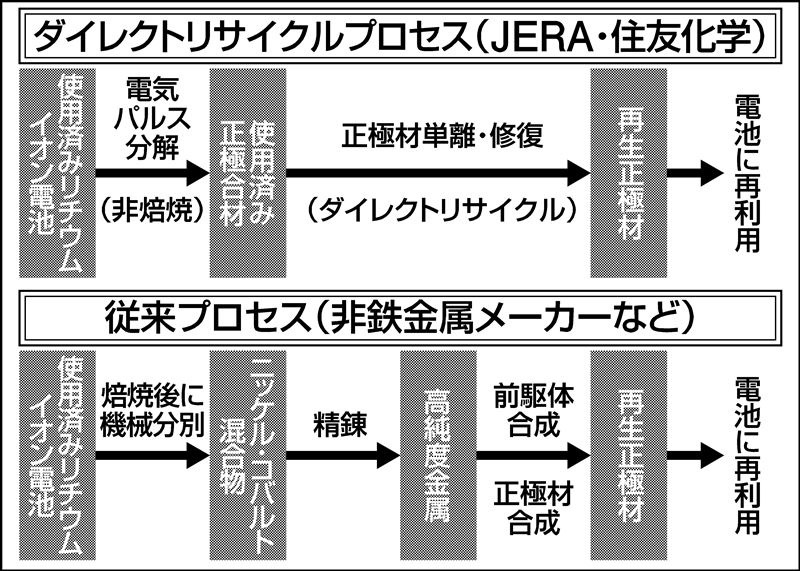

LIB: 95% recovery of cobalt and nickel!
-Overview of “Direct Recycling” technology-
JERA
Sumitomo Chemical
Repair and regenerate the structure of the positive electrode material of LIB without turning it back to metal.
Started joint development of “direct recycling” technology.
Compared to the conventional method involving roasting (high-temperature heating) and metal refining, the environmental impact is reduced.
From fiscal 2023, automobile manufacturers will begin evaluating and verifying recycled cathode materials.
Aiming for commercialization after FY2030 in line with the expansion of the EV market.
What is Direct Recycling:
A technology for repairing the structure of cathode materials invented by Sumitomo Chemical 10 years ago.
JERA:
The positive electrode material taken out in the previous step has adhered binder and the like, and has deteriorated due to charging and discharging.
“Repair the crystal structure by adding a certain component to this and firing it.”
What this ingredient does:
Generated by firing fluororesin binder,
It also suppresses the generation of hydrofluoric acid, a hazardous material, and can be safely recovered as a solid.
The component to be added is properly used for each type of positive electrode material.
Structural repair technology for cathode materials:
Sumitomo Chemical thought, “Sooner or later, it will be necessary to recycle the cathode material.”
It applies “technology to create an ordered structure when manufacturing cathode materials.”
Sumitomo Chemical
Kyoto University
We have been jointly conducting lab-level demonstrations.
In 2022, at the Ehime Factory (Niihama City, Ehime Prefecture),
Establish a new dedicated test facility for regenerating more than ten kilograms in one treatment.
JERA:
Discharging used batteries to render them harmless,
Positive and negative electrodes, separators, and electrolytes are separated and collected.
The positive material is peeled off by “irradiating an electric pulse” to the “member where the positive electrode material etc. are attached to the metal foil”.
Irradiation of electrical pulses:
The method of irradiating the electric pulse is
Compared to the roasting method used by non-ferrous metal manufacturers, it reduces CO2 emissions and increases the metal recovery rate.
Technological development of both companies:
Adopted as a NEDO support project.
Business goals:
95% recovery of cobalt-nickel, 70% lithium.
Development of direct recycling technology:
The U.S. Department of Energy is also working on the “development of direct recycling technology for cathode materials.”
Resource circulation technology is an important element that supports the EV strategy of each country.
new switch
LIB : 95% de récupération du cobalt et du nickel !
-Aperçu de la technologie “Recyclage direct”-
JÉRA
Produits chimiques Sumitomo
Réparez et régénérez la structure du matériau d’électrode positive de LIB sans le transformer en métal.
Début du développement conjoint de la technologie de “recyclage direct”.
Par rapport à la méthode conventionnelle de torréfaction (chauffage à haute température) et d’affinage des métaux, l’impact environnemental est réduit.
À partir de l’exercice 2023, les constructeurs automobiles commenceront à évaluer et à vérifier les matériaux cathodiques recyclés.
Viser la commercialisation après l’exercice 2030 conformément à l’expansion du marché des véhicules électriques.
Qu’est-ce que le recyclage direct :
Une technologie de réparation de la structure des matériaux cathodiques inventée par Sumitomo Chemical il y a 10 ans.
JÉRA :
Le matériau d’électrode positive retiré à l’étape précédente a adhéré à un liant et similaire, et s’est détérioré en raison de la charge et de la décharge.
“Réparez la structure cristalline en y ajoutant un certain composant et en le tirant.”
Que fait cet ingrédient :
Généré par la cuisson d’un liant de résine fluorée,
Il supprime également la génération d’acide fluorhydrique, une matière dangereuse, et peut être récupéré en toute sécurité sous forme solide.
Le composant à ajouter est correctement utilisé pour chaque type de matériau d’électrode positive.
Technologie de réparation structurelle pour les matériaux cathodiques :
Sumitomo Chemical pensait : « Tôt ou tard, il sera nécessaire de recycler le matériau de la cathode ».
Il applique “la technologie pour créer une structure ordonnée lors de la fabrication de matériaux cathodiques”.
Produits chimiques Sumitomo
Université de Kyoto
Nous avons mené conjointement des démonstrations en laboratoire.
En 2022, à l’usine d’Ehime (ville de Niihama, préfecture d’Ehime),
Mettre en place une nouvelle installation de test dédiée pour régénérer plus de dix kilogrammes en un seul traitement.
JÉRA :
Décharge des batteries usagées pour les rendre inoffensives,
Les électrodes positives et négatives, les séparateurs et les électrolytes sont séparés et collectés.
Le matériau positif est décollé en “envoyant une impulsion électrique” à “l’élément où le matériau d’électrode positive, etc. est fixé à la feuille métallique”.
Irradiation d’impulsions électriques :
La méthode d’irradiation de l’impulsion électrique est
Par rapport à la méthode de torréfaction utilisée par les fabricants de métaux non ferreux, elle réduit les émissions de CO2 et augmente le taux de récupération des métaux.
Développement technologique des deux sociétés :
Adopté en tant que projet de soutien NEDO.
Objectifs d’affaires:
95% de récupération de cobalt-nickel, 70% de lithium.
Développement de la technologie de recyclage direct :
Le département américain de l’Énergie travaille également sur le “développement d’une technologie de recyclage direct pour les matériaux cathodiques”.
La technologie de circulation des ressources est un élément important qui soutient la stratégie VE de chaque pays.
nouvel interrupteur
LIB: 95 % Rückgewinnung von Kobalt und Nickel!
-Überblick über die „Direct Recycling“-Technologie-
JERA
Sumitomo Chemical
Reparieren und regenerieren Sie die Struktur des positiven Elektrodenmaterials von LIB, ohne es wieder in Metall umzuwandeln.
Beginn der gemeinsamen Entwicklung der „Direct Recycling“-Technologie.
Im Vergleich zum herkömmlichen Verfahren mit Rösten (Hochtemperaturerhitzen) und Metallveredelung wird die Umweltbelastung reduziert.
Ab dem Geschäftsjahr 2023 werden Automobilhersteller mit der Bewertung und Verifizierung von recycelten Kathodenmaterialien beginnen.
Kommerzialisierung nach dem Geschäftsjahr 2030 im Einklang mit der Expansion des EV-Marktes angestrebt.
Was ist direktes Recycling:
Eine Technologie zur Reparatur der Struktur von Kathodenmaterialien, die vor 10 Jahren von Sumitomo Chemical erfunden wurde.
JERA:
Das im vorherigen Schritt herausgenommene Material der positiven Elektrode weist anhaftende Bindemittel und dergleichen auf und hat sich aufgrund des Ladens und Entladens verschlechtert.
“Reparieren Sie die Kristallstruktur, indem Sie eine bestimmte Komponente hinzufügen und brennen.”
Was diese Zutat bewirkt:
Erzeugt durch Brennen von Fluorharz-Bindemittel,
Es unterdrückt auch die Bildung von Flusssäure, einem gefährlichen Material, und kann sicher als Feststoff zurückgewonnen werden.
Die hinzuzufügende Komponente wird für jede Art von positivem Elektrodenmaterial geeignet verwendet.
Strukturelle Reparaturtechnologie für Kathodenmaterialien:
Sumitomo Chemical dachte: “Früher oder später wird es notwendig sein, das Kathodenmaterial zu recyceln.”
Es wendet “Technologie an, um bei der Herstellung von Kathodenmaterialien eine geordnete Struktur zu schaffen”.
Sumitomo Chemical
Universität Kyoto
Wir haben gemeinsam Demonstrationen auf Laborebene durchgeführt.
2022 in der Ehime-Fabrik (Stadt Niihama, Präfektur Ehime)
Einrichtung einer neuen speziellen Testanlage zur Regeneration von mehr als zehn Kilogramm in einer Behandlung.
JERA:
Altbatterien entladen, um sie unschädlich zu machen,
Positive und negative Elektroden, Separatoren und Elektrolyte werden getrennt und gesammelt.
Das positive Material wird durch “Einstrahlen eines elektrischen Impulses” auf das “Element, wo das Material der positiven Elektrode usw. an der Metallfolie angebracht ist” abgezogen.
Einstrahlung elektrischer Impulse:
Das Verfahren zum Einstrahlen des elektrischen Impulses ist
Im Vergleich zum Röstverfahren der NE-Metallhersteller reduziert es den CO2-Ausstoß und erhöht die Metallrückgewinnungsrate.
Technologische Entwicklung beider Unternehmen:
Als NEDO-Unterstützungsprojekt angenommen.
Geschäftsziele:
95 % Rückgewinnung von Kobalt-Nickel, 70 % Lithium.
Entwicklung der Direktrecycling-Technologie:
Auch das US-Energieministerium arbeitet an der „Entwicklung einer direkten Recyclingtechnologie für Kathodenmaterialien“.
Die Ressourcenzirkulationstechnologie ist ein wichtiges Element, das die EV-Strategie jedes Landes unterstützt.
neuer Schalter